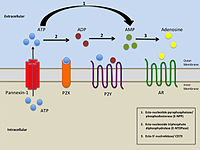| Part of a series on |
| Purinergic signalling |
|---|
 |
| Concepts |
| Membrane transporters |
P2Y receptors are a family of purinergic G protein-coupled receptors, stimulated by nucleotides such as adenosine triphosphate, adenosine diphosphate, uridine triphosphate, uridine diphosphate and UDP-glucose.To date, 8 P2Y receptors have been cloned in humans: P2Y1, P2Y2, P2Y4, P2Y6, P2Y11, P2Y12, P2Y13 and P2Y14.[1]
P2Y receptors are present in almost all human tissues where they exert various biological functions based on their G-protein coupling. P2Y receptors mediate responses including vasodilation,[2] blood clotting,[3] and immune response.[4] Due to their ubiquity and variety in function, they are a common biological target in pharmacological development.[3]
- ^ Abbracchio MP, Burnstock G, Boeynaems JM, Barnard EA, Boyer JL, Kennedy C, Knight GE, Fumagalli M, Gachet C, Jacobson KA, Weisman GA (September 2006). "International Union of Pharmacology LVIII: update on the P2Y G protein-coupled nucleotide receptors: from molecular mechanisms and pathophysiology to therapy". Pharmacological Reviews. 58 (3): 281–341. doi:10.1124/pr.58.3.3. PMC 3471216. PMID 16968944.
- ^ Cite error: The named reference
Romanello_2006was invoked but never defined (see the help page). - ^ a b Cite error: The named reference
Erlinge_2011was invoked but never defined (see the help page). - ^ Cite error: The named reference
pmid17135283was invoked but never defined (see the help page).